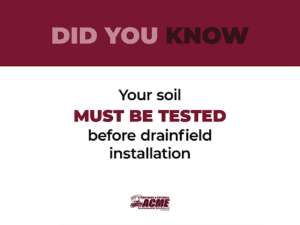It Won’t Last Forever: How To Know When You’ll Need An Orlando Drainfield Replacement
It Won’t Last Forever: How To Know When You’ll Need An Orlando Drainfield Replacement
Septic systems are relatively maintenance-free, but like all good things, they don’t last forever. Here’s how to tell when it’s time for an Orlando drainfield replacement.
It’s often overlooked, but at Acme, we know that your drainfield is just as important as your septic tank in your septic system. But what is a drainfield, what maintenance does it need, and how long will it last? We will answer all of your burning questions about your drainfield and how to know when you need an Orlando drainfield replacement.
What Is A Drainfield?
When you think of a septic system, you may think of the tank and that’s it. While your septic tank is a vital part of your septic system, it’s just the first stop for your household’s wastewater.
From your septic tank, your wastewater travels through a series of underground pipes, where it percolates through the soil, and is then distributed as groundwater. This is your drainfield (also called a leach field, leach bed, filter bed, or percolation bed). In an effort to distribute water efficiently, drainfields are typically buried in a large area near the septic tank.
How Do You Care For Your Drainfield?
It’s pretty simple to take care of your drainfield – basically, if you leave it alone, it will do its work well. If you follow a few rules for drainfield maintenance, you shouldn’t need an Orlando drainfield replacement for many years.
- Don’t plant vegetation on top of your drainfield. Roots can grow into the pipes and cause cracks, leaks, and other damage. You’ll also lose your rose bushes if you need any work done on your drainfield, and you don’t want that!
- Don’t build on top of your drainfield. Your drainfield isn’t sturdy enough to withstand the weight of a structure of any kind, whether it’s temporary or permanent. Not only will structures damage your drainfield, but you’ll also have to move the structure if you need any work done to your drainfield.
When Should You Replace Your Drainfield?
With proper care and maintenance, your drainfield should last up to 30 years. When you buy a home with a septic system, you should find out when the drainfield was installed so you’ll know when it should be replaced.
To maximize the lifespan of your drainfield, look for these symptoms of potential underlying problems. Addressing issues right away will stave off your Orlando drainfield replacement a little (or a lot) longer.
- Wet, soggy ground over your drainfield – When the ground above your drainfield is wet, and it hasn’t rained lately, you may have a leak that’s letting too much water escape from your pipes.
- Exceptionally lush vegetation over your drainfield – Because the water coming from your septic system is a great fertilizer, it’s an environmentally-friendly way to take care of your lawn. However, if the area above your drainfield is extra green, it can be a sign of a leak or other damage.
What’s Involved In An Orlando Drainfield Replacement?
Before we install a new drainfield, we remove all components of your existing drainfield. Next, we install a series of lateral pipes into trenches on a slightly downhill slope. Finally, we fill the trenches with several inches of dirt, leaving the ends of the pipes exposed to allow access.
Can You DIY Your Drainfield?
There are many reasons that an Orlando drainfield replacement is not a DIY job. At Acme, we have the equipment to efficiently remove old materials and install new materials. Our technicians are licensed, certified, and trained to do the job right the first time. When you’re ready for a new drainfield, or if you have any questions about your septic system, contact Acme today.

